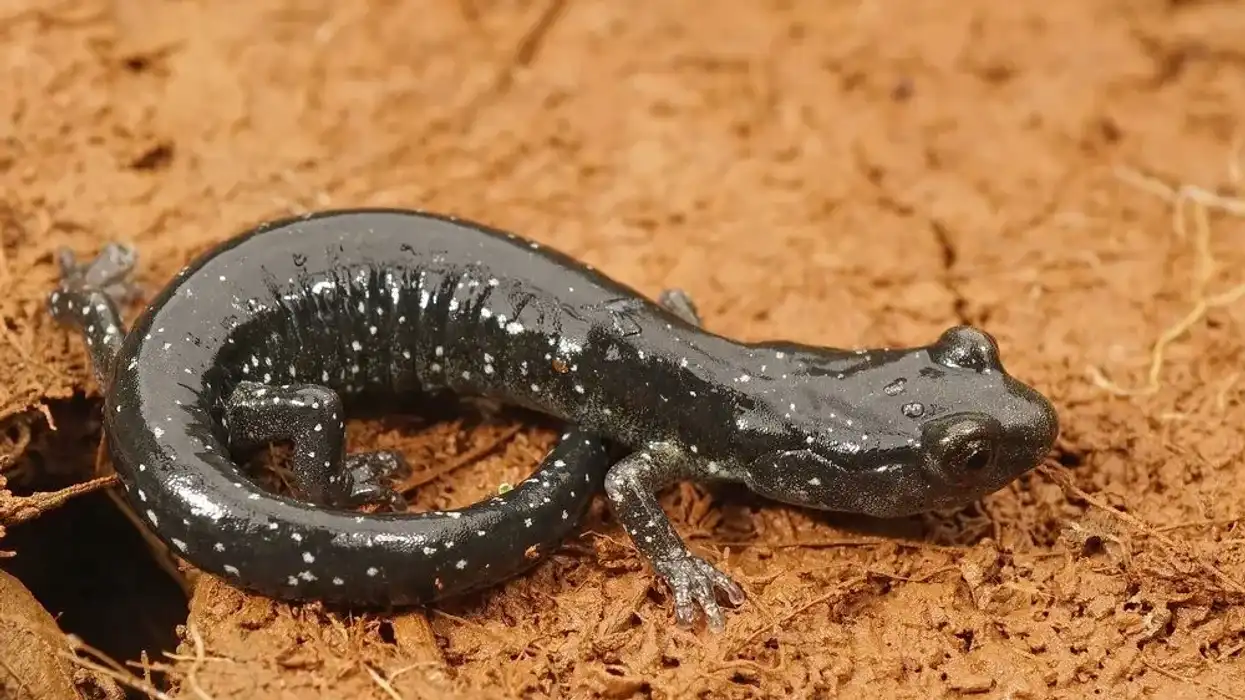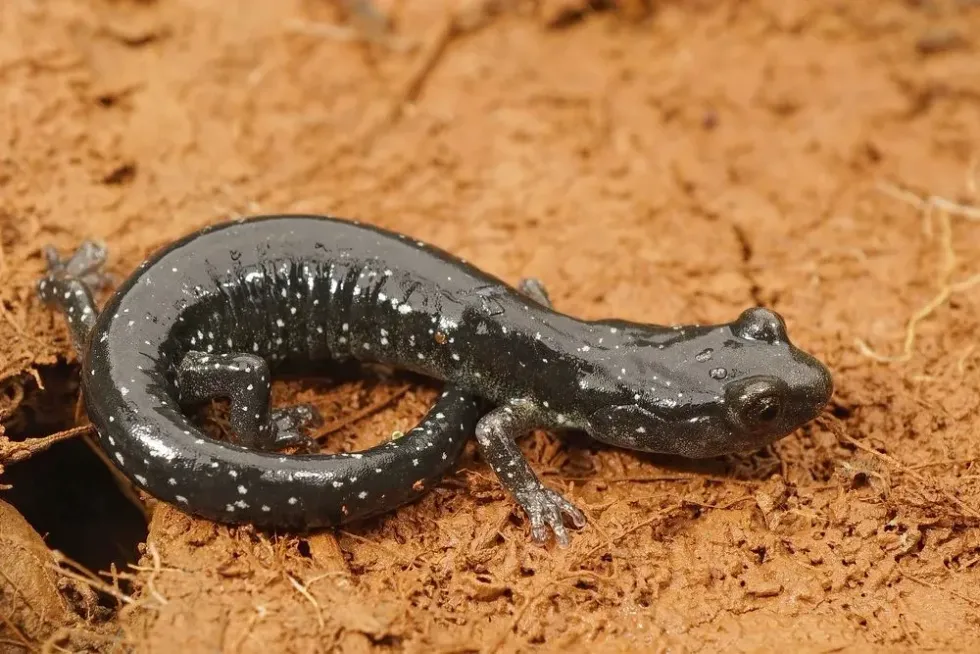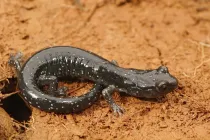Fun Black Salamander Facts For Kids

The Aneides flavipunctatus is one among the rarest of all from the family of salamanders. As the name goes, the black salamander is easily identified by its black body.
This black body is adorned with tiny spots, either white, yellow, or cream in color, and a long tail. The presence of these tiny speckles also gives this species its other name, the spotted/speckled black salamander.
This member of the Plethodontidae family, unfortunately, has their populations in danger, and conservation is of urgent need. The black salamander population is found to be restricted mainly within the United States of America.
Situations such as habitat destruction and larger predators have endangered the population of this species. If these young terrestrial amphibians of this species feel doubtful or fear in any situation, they would immediately freeze, trying to merge and seem to be a part of the habitat around it.
And mind you, if you dare challenge these Plethodon, they are all set to have a good combat.
Are you having a good time reading about the black salamander? We also have exciting information on our pages of tiger salamander facts and hellbender salamander facts.
Black Salamander Interesting Facts
What type of animal is a black salamander?
The Aneides flavipunctatus is a type of salamander.
What class of animal does a black salamander belong to?
The black salamander is an amphibian, belonging to the class Plethodontidae.
How many black salamanders are there in the world?
There is no exact information on the Aneides flavipunctatus population.
Where does a black salamander live?
The speckled black salamander location is mainly in grasslands and temperate forest regions.
What is a black salamander's habitat?
Common places to spot this amphibian are in the Southwestern region of the United States of America. They are found in dense forests and grasslands.
Usually, the distribution of their populations are at elevations under 2000 ft (600 m), however, they might be in higher altitudes, which might be up to 5600 ft (1700 m). They are usually found hidden under rocks, leaf litter, and logs.
You can spot these dark-skinned salamanders in the northern regions, usually lurking in an open, less dense country habitat.
Santacruz Mountain range is the most southern point where you can spot these salamanders. Coming a little upward, there is no habitat where you can find them. The next stop to spot these slimy ones are in southern Oregon as well as the northern regions of California.
Who do black salamanders live with?
Salamanders, in general, do not like living in large groups. They live usually alone and only meet others during the breeding months.
How long does a black salamander live?
These dark-skinned salamanders can actually live quite long lives. These amphibians have been recorded to be living for more than 30 years, usually being around 18-25 years of age.
How do they reproduce?
During the breeding months, these black salamanders come out from their homes and wander near water bodies to find potential mates for mating. Once they find potential female black salamanders near them, male salamanders dance and wiggle their tails.
They then grab the potential mate with their hind limb around their bodies and let them go. This little game keeps going on until the male wants to mate.
He then drops germ cells to the bottom of the close water bodies. The females then follow their mate and go to the same location and absorb the germ cells within their bodies to let the eggs mature with these cells.
The eggs are then laid in the month of July to August. They are laid in underground chambers, where the eggs are attached to the damp soil.
Females guard their eggs until they hatch. The little larvae hatch on land, and not in water.
What is their conservation status?
The conservation status of the Aneides flavipunctatus stated in the IUCN Red List is 'Near Threatened'.
Black Salamander Fun Facts
What do black salamanders look like?
The bodies of black salamanders are, as the name suggests, black in color. The adults also sport some small white, pale red, orange, or yellow spots. These amphibians might also have black skin with a grey-green sheen.
Their undersides are considerably paler. The younger ones of this species have greyish-green or bronze anatomy, with mustard/beige skin at the base of their feet. They have triangular heads. Their bodies are slim and slender.
Their tails are very long and potted. Once they hatch from eggs, the newborn Aneides flavipunctatus has a strong tail, gills, good vision, and a properly functioning body. The gills and fins of the juveniles disappear as these salamanders reach adulthood.

How cute are they?
We do not find the Aneides flavipunctatus cute, sorry!
How do they communicate?
We do not have information related to their communication habits.
How big is a black salamander?
These adult terrestrial black salamanders can grow up to a length of 2.4-3 in (6-7.5 cm).
This body length is almost a little bigger than a wooden toothpick.
How fast can a black salamander move?
There are no records on the speed of the black salamanders of genus Aneides.
How much do black salamanders weigh?
We do not have any information on the body weights of the Aneides flavipunctatus.
What are their male and female names of the species?
There are no separate specific names for the females and males of this species.
What would you call a baby black salamander?
Little salamanders in general are called efts.
What do they eat?
Black salamanders are primarily carnivorous in their diet. The Aneides flavipunctatus diet includes invertebrates smaller than this species. These include termites, millipedes, ants, and even beetles. The younger ones eat springtails and flies, too. Leeches, waxworms, aquatic bugs, and newborn mice are also on the menu of this amphibians’ meal.
Is the black salamander poisonous?
Yes, the Aneides flavipunctatus secretes a sticky, poisonous substance when they are at threat to use it against their predators.
Would they make a good pet?
We do think the speckled black salamander would make a good pet. You can read more about the ways to care for black salamanders below.
Did you know...
In situations of threat, the juveniles of this kind remain frozen in their places, trying to merge with their surroundings and not stand out. The adults, however, make a quick attempt in escaping and hiding under the rocks and logs.
They defend themselves by overpowering the opposite threat by raising their stance and standing straight. The adults then lower their heads and wave the long tail.
They might even jump to startle the threat. Biting is also an escape mechanism for these adults, they would release the poisonous toxin from their skin.
The distribution of their populations is traced in northern regions of California, south of Oregon, the eastern region of Trinity Mountains, southern Southern Sonoma County, northern San Francisco Peninsula region as well as Mountain Shasta.
The Aneides flavipunctatus is a proud member of the family Plethodontidae, comprising of all the lungless salamanders.
Being a Plethodon, this amphibian carries out respiration entirely through the skin as well as the lining of tissues around the mouth. Hence, this arrangement of their bodies requires them to inhabit damp, moist areas on land. Only in cases of high humidity, these little salamanders would crawl onto land. This makes them terrestrial beings.
This speckled species also has special nasolabial grooves. These grooves are straight slits that run down from their upper lip to their nostrils and have glands.
This species is very territorial.
The scientific name of this species, Aneides flavipunctatus, is formed from the Greek term Aneides and the Latin word flavipunctatus. ‘Aneides’ translates to ‘lacking a specific shape or form’, whereas ‘flavipunctatus’ translates to ‘yellow spotted’, which refers to the appearance of this species.
They do not prefer much company and love living in solitude.
These animals are combative in nature.
Environments with high concentrations of chlorine are highly toxic to these salamanders.
To attract females, the male speckled/spotted black salamanders perform a special dance to impress them for mating.
Common predators of this species are larger salamanders, snakes, and other large animals.
This species is known to have multiple disjunctive populations.
Why is the black salamander endangered?
Under the Red List of Threatened Species by the IUCN, spotted black salamanders have been categorized as a species whose population is Near Threatened. Numerous reasons have contributed to the decline of the individuals of the Aneides flavipunctatus species.
Loss of habitat is one of the main reasons for this species being endangered. An environment that remains undegraded also happens to be a reason.
Some of the living regions of these amphibians have been displaced and disturbed by converting them into agricultural lands, such as planting around vineyards. Throwing trash near their habitats has also led to a decline in the quality of the environment they live in.
How to care for a black salamander?
This species is absolutely easy to manage when it comes to caring for them. They make really good pets. Minimal efforts are required to take care of these amphibians, and before you know it, you have got a bestie with you!
Keeping these animals at home would require a nice comfortable and easy-to-care home. A transparent case/tank would make a great house for this small species.
They might also need small objects to hide around, as these amphibians are pretty shy! Rocks, small logs can be kept inside the tanks.
The least you can arrange for them is by using shoe boxes or similar boxes to keep them in. Make sure these boxes have tiny holes around them to allow spotted black salamanders to breathe in air.
Let your little black salamander enjoy their time! Keep a few plastic rods, pipes, or barks in the homes so that they can play around their habitat and climb them.
Salamanders always need a moist atmosphere. Hence, ensure to keep a small clump of wet/damp soil in the house. Make sure you wet this substrate often and do not let it get dried up.
Avoid using water with high concentrations of salts. Springwater, distilled water, or even plain tap water can be given. Keep water in an open container/bowl. Salamanders might either drink it, or clean themselves by soaking in this water, so ensure your container/bowl is big enough.
Be relaxed when it comes to dietary requirements. These little salamanders need not be fed every day, but every alternate day you can give them something to gobble up. Earthworms, waxworms, and tiny insects can be given as food. Some even recommend dusting (not coating) their food with vitamin supplements and calcium powders.
The best temperature setting for them can be set within the range of 55-65 °F (12-18°C). This speckled black amphibian can withstand temperatures up to 80°F (27°C), but it is always better not to cross the optimal levels. Ensure the air is clean and not dusty.
The presence of salts or chemicals is very harmful to these creatures. Even human sweat is harmful to them. Hence, ensure you always wash your hands with clean water (even without the presence of chlorine) before you handle them. Do not pull them from their positions, instead, let them be comfortable and climb on your hands themselves.
Even while letting them go, do not drop them from a height. Let them comfortably step down and walk around. Do not disturb them from their hiding spots. Give them their time.
Learn more about some other salamanders on our pages on the amazing spring salamander facts, or the barton springs salamander facts pages.
You can even have a good time at home by coloring on one of our free printable Black salamander coloring pages.
We Want Your Photos!
More for You
Bachelor of Arts specializing in English Literature

Akinwalere OlaleyeBachelor of Arts specializing in English Literature
As a highly motivated, detail-oriented, and energetic individual, Olaleye's expertise lies in administrative and management operations. With extensive knowledge as an Editor and Communications Analyst, Olaleye excels in editing, writing, and media relations. Her commitment to upholding professional ethics and driving organizational growth sets her apart. She has a bachelor's degree in English Literature from the University of Benin, Edo State.
Bachelor of Arts specializing in Economics

Gowri RaoBachelor of Arts specializing in Economics
With a bachelor's degree in Economics from Krea University, Gowri is a highly skilled data analyst and an expert in regression and causation modeling. Her interests in economic trends, finance, and investment research complement her professional expertise. In addition to her professional pursuits, Gowri enjoys swimming, running, and playing the drums, and she is also a talented tutor.
Disclaimer
1) Kidadl is independent and to make our service free to you the reader we are supported by advertising. We hope you love our recommendations for products and services! What we suggest is selected independently by the Kidadl team. If you purchase using the Buy Now button we may earn a small commission. This does not influence our choices. Prices are correct and items are available at the time the article was published but we cannot guarantee that on the time of reading. Please note that Kidadl is a participant in the Amazon Services LLC Associates Program, an affiliate advertising program designed to provide a means for sites to earn advertising fees by advertising and linking to Amazon. We also link to other websites, but are not responsible for their content.
2) At Kidadl, we strive to recommend the very best activities and events. We will always aim to give you accurate information at the date of publication - however, information does change, so it’s important you do your own research, double-check and make the decision that is right for your family. We recognise that not all activities and ideas are appropriate for all children and families or in all circumstances. Our recommended activities are based on age but these are a guide. We recommend that these ideas are used as inspiration, that ideas are undertaken with appropriate adult supervision, and that each adult uses their own discretion and knowledge of their children to consider the safety and suitability. Kidadl cannot accept liability for the execution of these ideas, and parental supervision is advised at all times, as safety is paramount. Anyone using the information provided by Kidadl does so at their own risk and we can not accept liability if things go wrong.
3) Because we are an educational resource, we have quotes and facts about a range of historical and modern figures. We do not endorse the actions of or rhetoric of all the people included in these collections, but we think they are important for growing minds to learn about under the guidance of parents or guardians.







